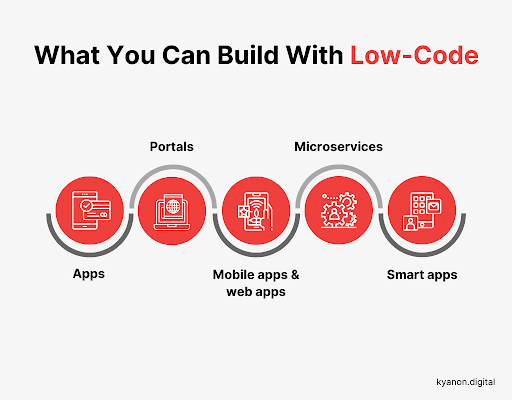Best News To Picking Low-Code Platform Info
Wiki Article
The Advantages Of Low-Code Development To Speed Up Development
Visual Development Environment:
Drag-and-Drop Interfaces: Low-code platforms provide visual tools for designing applications. Developers can use drag-and-drop components to build applications quickly without writing a large amount of code.
A lot of low-code platforms come with already-built templates or components that allow developers to quickly prototype applications and then build them without having to start with a blank slate.
Coding needs that are reduced:
Automated Generated Code: Lowcode platforms create the code base on the visual models that developers have created. This reduces manual coding, and accelerates the process of developing.
Reusable Components: Developers may use reusable components across different projects, minimizing the time they spend creating and testing code.
Collaboration streamlined:
Integration of Development Tools: Low-code tools often include tools for version control as well as testing and deployment that allow seamless collaboration between development teams.
Citizen Development Business users, non-developers and other users can all help in the creation of applications by using user-friendly interfaces. This helps to reduce the bottleneck caused by absence of experienced developers.
Rapid Iteration and Prototyping
Fast Prototyping: Developers can quickly build prototypes that can be used to test ideas and collect feedback, resulting in quicker the cycle of iterations.
Easy Modifications - The visual nature low-code application development allows for simpler updates and modifications which speed the refinement of applications based upon user feedback.
Pre-built Integrations:
API Integrations Low-code platforms include already built connectors that can be used with the most popular APIs or services. They can speed up the process it takes to integrate external applications.
Data Integration: Inbuilt instruments to integrate data simplify the process of connecting databases and other sources of data and speeding development.
Scaling, deployment and deployment:
One-Click deployment: A lot of platforms that make use of low-code have the option of deploying with one click applications, reducing the time and effort.
Cloud-Based Solutions: Cloud-based low-code platforms can manage scaling and infrastructure management and allow developers to focus on application logic and functionality rather than the logistics of deployment.
The overall rapid development of low-code apps lies in its ability simplify and automate various aspects of the development process. This facilitates faster development of apps and faster adaption to the changing demands. Read the best Low-code Platform for application development for blog recommendations including mobile app development platforms, low code development platforms, rad application development, application modernisation, driver jdbc, mobile app development platforms, rapid application design, rad application development, mobile development platforms, rapid action development and more.

Benefits Low-Code Apps In Safety And Governance
Low-code development of apps offers numerous benefits for security and governance. This is essential to ensure that applications are compliant with regulations, are secure and are well managed throughout their lifespan. Below are the advantages of developing low-code applications:
Unified Manage Console: Lowcode-based platforms typically have a management console which allows administrators to supervise and manage applications.
Role-Based Access Control RBAC: These platforms are equipped with robust role-based controls that allow administrators to set access rules. This makes sure that only users who are authorized have the ability to access or modify specific areas of the application.
Compliance and Regulatory Conformity:
Built-in Compliance Features: Many low-code platforms are designed to conform to the industry standards as well as regulations (e.g. GDPR, HIPAA). They provide templates and tools to ensure that their applications comply with these standards.
Audit Trails and Logging: Audit trails and logs that are comprehensive are typically integrated, allowing organizations to track changes, monitor access, and ensure compliance with internal as well as external laws.
Additional Security Measures
Data Encryption Low-code platforms typically come with built-in encryption of data during transport and in rest, securing sensitive information.
Security Certifications - Many lowcode providers hold security certifications such as ISO 27001 (or SOC2) which proves the compliance to high security standards. The customers can be confident that these providers adhere to these standards.
Automated security updates:
Regular patches and updates Low-code platforms manage the majority of security patches and updates in a way. They make sure that applications are secure from the latest threats without having developers intervene manually.
Security Monitoring: Continuous security monitoring tools can be included to provide real-time notifications and insights on potential security problems.
Data Governance
Data Access Policies: These systems allow companies to establish and enforce policies regarding data access to ensure that data is only accessible only to those who have been granted access and is utilized in a proper manner.
Data Masking and Anonymization: Built-in tools for data masking & anonymization safeguard sensitive data, particularly in testing environments and development environments.
Continuous application lifecycle management
Pipelines for deployment and development Low code platforms have integrated development and deploy pipelines which include security checks. They ensure security is maintained throughout the entire application lifecycle.
Version Control - The integrated version control helps monitor modifications to applications, and permits users to revert them when needed. They also ensure the integrity and quality of the application.
User Authentication and Authorization:
Single Sign On (SSO) Single Sign On (SSO): Supporting single sign-on and other advanced authentication techniques simplify management of users while increasing security.
Multi-Factor Authentication (MFA): Many platforms offer built-in support for multi-factor authentication. It adds an additional layer of security when accessing applications.
Compliance Monitoring and Policy Enforcement Compliance Monitoring:
Low-code platform often comes with policies templates pre-defined that enable organizations to implement cybersecurity and governance policies quickly.
Compliance Monitoring Tools They provide regular monitoring and report on compliance status, which makes it easier to recognize and resolve possible issues in advance.
Integration into Existing Security Infrastructure
Seamless Integration: Platforms that use low-code technology are built to integrate seamlessly with tools and infrastructure like SIEM (Security Information and Event Management solutions) and firewalls.
API Security: API integrated security ensures integrations with external systems are secured. Protect data and maintain application consistency.
Best practices and training:
Many platforms offer guides and best practice for secure application development. They can help developers who are not developers to comply with security standards.
Security Training: Certain low-code providers provide security training and resources that help users understand how to design and build secure applications.
Overall, the governance and security features assure that applications are developed and maintained in a secure manner and in accordance with regulations, and under control. These platforms contain the frameworks and tools needed to manage and oversee the development of applications, as well as protect sensitive data while maintaining regulatory compliance and enforcing policies. Have a look at the recommended Enterprise application development with Low-code Platform info for site tips including rad development, rad application development, rapid app development, develop web application, lowcode no code, app dev platform, azure sql server, jdbc server, develop mobile application, app development platform and more.

Support From Vendors And Community Are Two Advantages Of Low Code Development For Applications.
Low-code development platforms for applications are a great way to get vendor support and community involvement. Both of these factors are essential to ensure a successful implementation and ongoing maintenance of the application. These are the major benefits: Support
Comprehensive Technical Support:
Dedicated Support Team: Many low code platforms have dedicated support personnel who can assist with technical issues in troubleshooting and assistance. They can make sure that problems are solved quickly.
Some vendors provide 24/7 support. This can be very useful for companies that operate in different time zones.
Training and Onboarding
Vendors provide structured training programs, such as webinars tutorials, and certificates to help users get familiar with the platform.
Personalized Onboarding Many vendors offer individualized services to assist their new customers get onboard effectively and customize it to their needs.
Regular updates and enhancements
Continuous Improvement : Low-code platforms vendors often release regular upgrades that include new functionality as well as performance improvements and security patches. These updates ensure that their platform stays secure and up-to-date.
Feedback Integration: Vendors incorporate feedback from their users into their development cycles to ensure that the platform is evolving to meet the changing requirements of their users.
Comprehensive Documentation:
Detailled Documentation: Comprehensive and well-organized documentation is typically available that covers everything from the basics of use to advanced customization, which helps users to find solutions without assistance.
API References Comprehensive API documentation allows developers to modify applications and connect low-code platforms with other platforms.
Consultancy and Professional Services
Expert Consultation. Vendors offer a wide range of consulting services, including architecture design along with strategic planning and platform implementations. These services ensure users get the most out of their platform.
Custom Development Services: Some companies provide custom development services to build specific features or integrations that aren't available in the standard package.
Community Support for the Community
Active User Communities:
Forums and discussion boards A lot of platforms with low-code feature a vibrant community where users can seek help, share solutions, and work together to discover the best practices.
User Groups and Meetups: Local and virtual user groups and meetups provide opportunities for networking, learning, and sharing experiences with fellow users.
Knowledge Sharing and collaboration:
Community-Contributed Resources: Users often share templates, modules, and extensions that they have developed, which can be reused or adapted by others, accelerating development and innovation.
Crowdsourced Solutions: The collective wisdom the experience, expertise and experiences of a community may prove to be a useful tool in solving problems and coming up with creative solutions.
Learning and Development
Community-Led Learning: Many communities host training sessions, workshops and webinars, which are usually run by experienced users who can provide insights and more advanced methods.
Online Courses and tutorials: Community members often develop and publish online courses, tutorials, and how-to guides, making better educational resources available to all users.
Feedback and Influence
Product Feedback: Many forums have channels for giving feedback to vendors. This feedback can affect the development of new features and enhancements.
Beta Testing Programs: Active community members might be able to be part of beta testing programs, giving them early access to new features as well as a say in influencing the evolution of the platform.
Recognition and Support
Community Recognition Programmes: Many vendors provide recognition programs for active members of the community. Examples include MVP (Most Valuable Professionals) which acknowledges their contributions of the community.
Peer Support. Community members provide assistance to each other. They offer their knowledge with users who are less familiar and provide guidance. This creates an atmosphere of collaboration and support.
Overall, the combination of robust vendor support with an active and engaged community creates an extensive support ecosystem to develop low-code applications. Users will have the knowledge and resources to develop, deploy and maintain their application.
